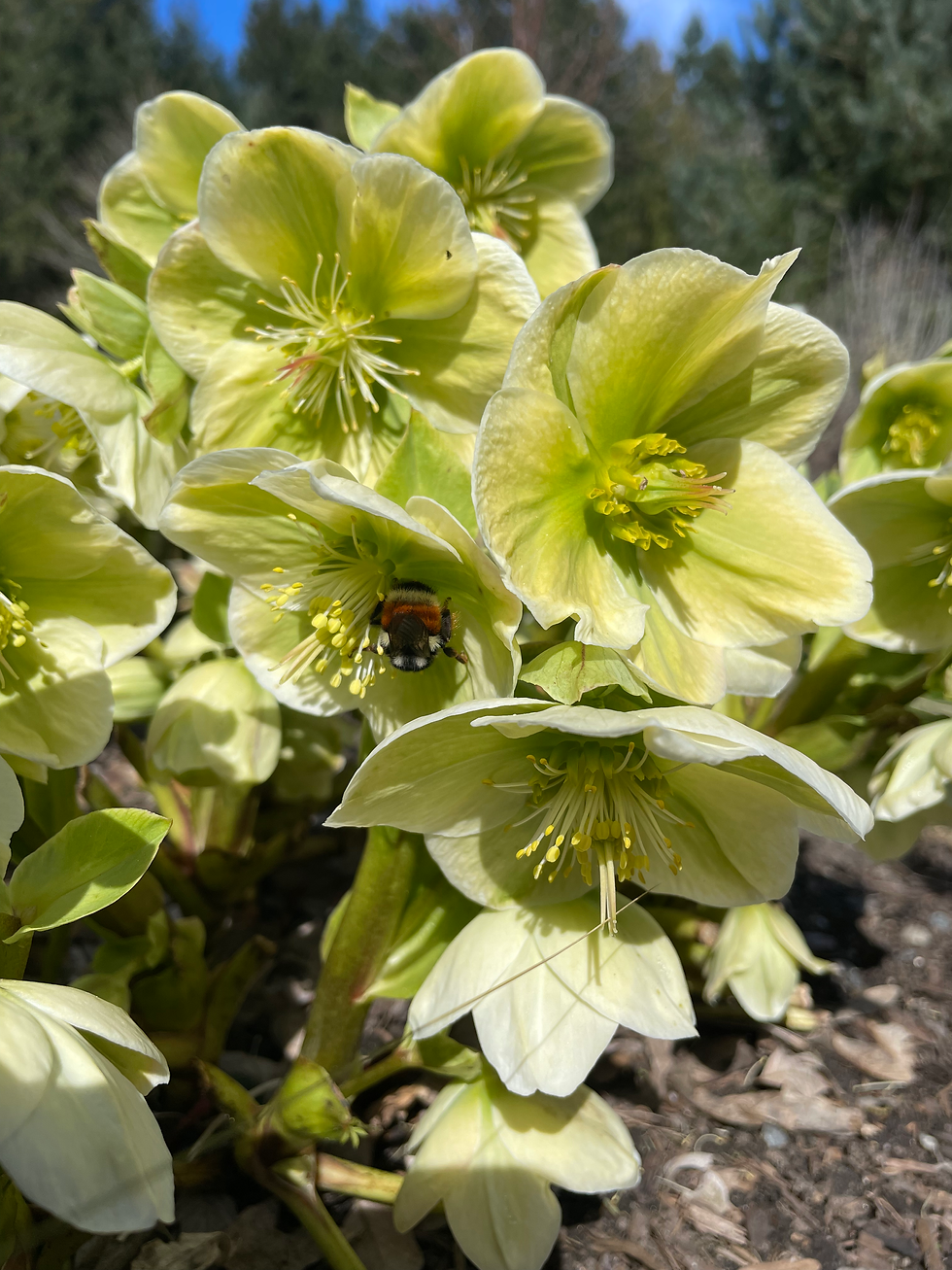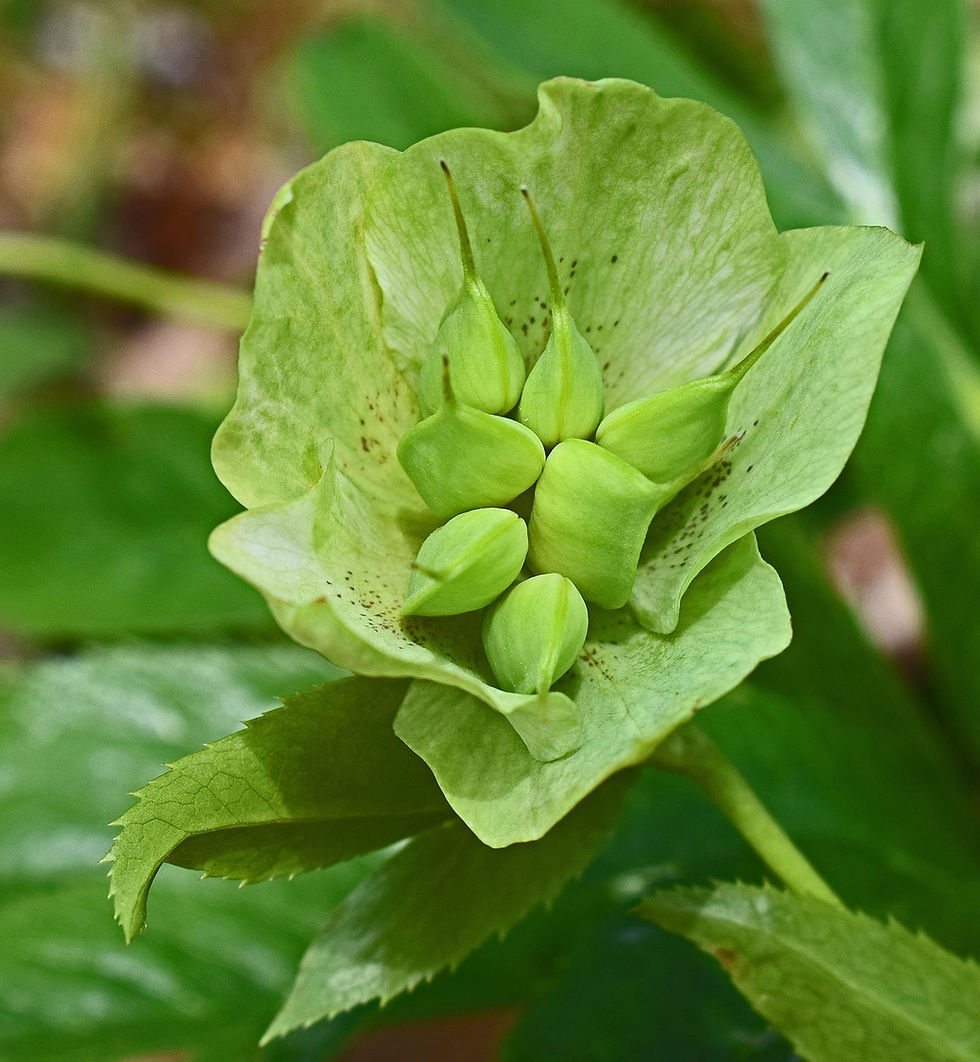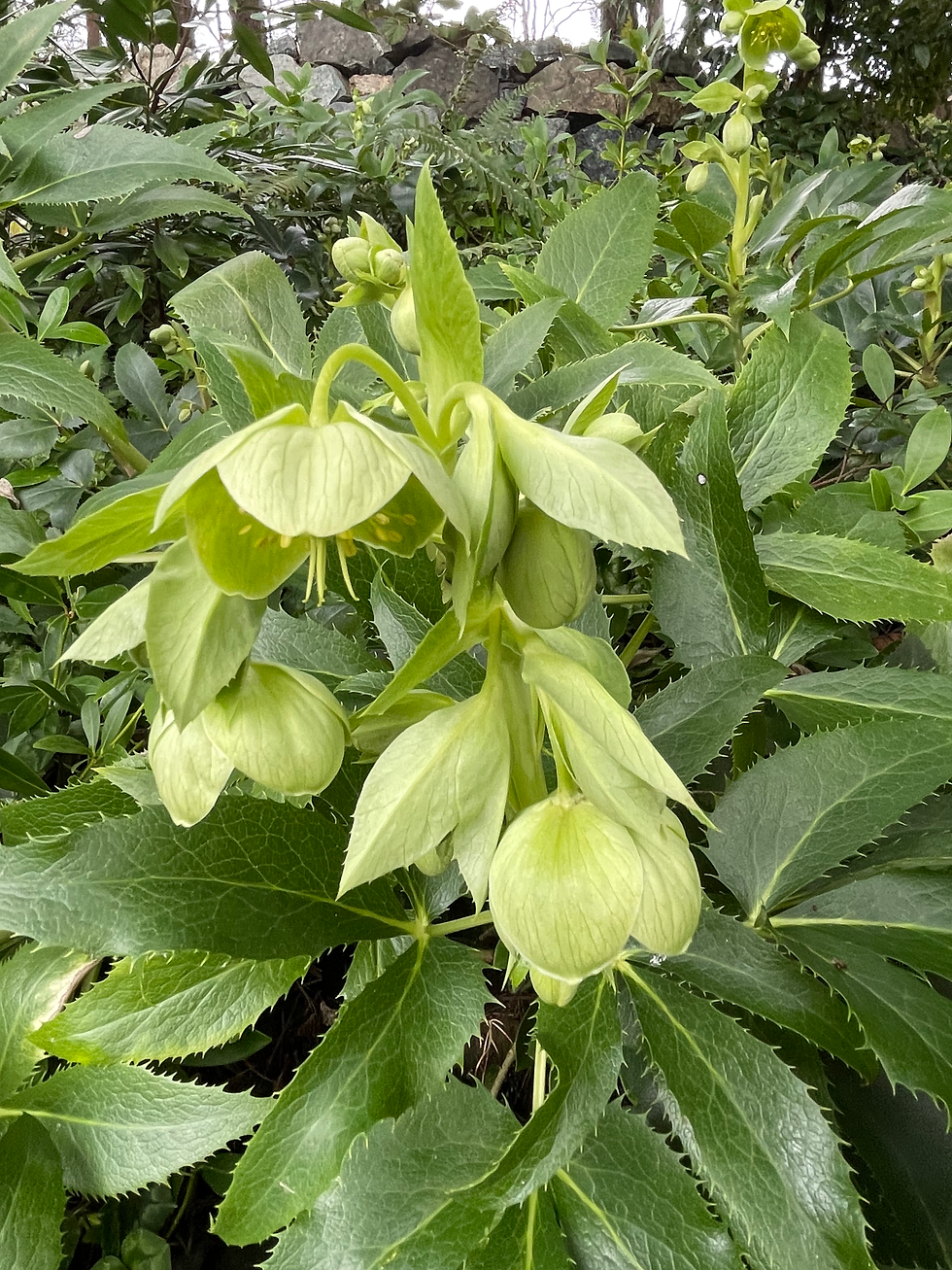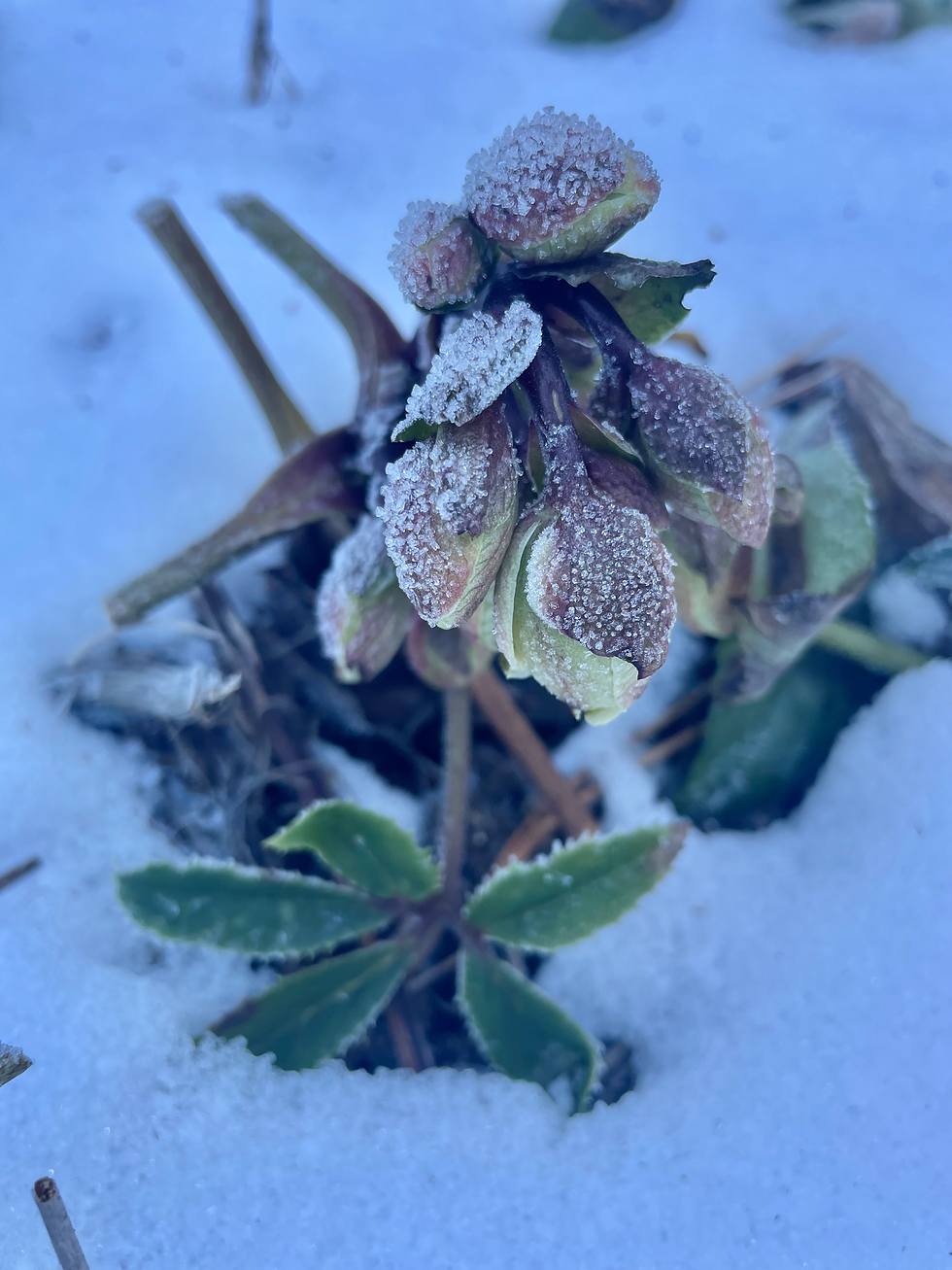Learn to Love... the Beauty of Species Hellebores
- lesannsa
- Feb 12
- 8 min read
Updated: Mar 16
February 2025

Hellebores play a critical role in the winter and early spring garden. Their lovely flowers emerge in late winter/early spring. The flowers are rich in nectar and pollen and provide an important food source for bees when little else is in bloom. The flowers last for up to 3 months and, when they finally start to fade, the spring bulbs are ready to take over the display. Even when not in flower, hellebores are impressive plants. In general, their leaves are evergreen and come in a variety of interesting forms. There are approximately 22 hellebore species and an unfathomable number of hellebore hybrids.
In the wild, hybridization occurs naturally within, and often between, hellebore species. This creates populations with large individual variations. Humans have been selectively crossbreeding individual hellebores for the last century. Since these new cultivars contain genes from so many different species, they are simply referred to as Helleborus x hybridus.
New cultivars offer: (1) a wider range of colours and colour shades (black, gray, yellow, red, pink, green, and white), (2) a greater variety of flower forms (single, double, anemone-center, sideway facing), and (3) an assortment of foliage characteristics (mottled, veined, silver, fanlike, palmate). New cultivars often "perform" better in the garden setting—more vigorous growth, earlier flowering, more flowers per plant, and longer flowering.
Over the last 20 years, huge advances have been made in hybridizing hellebores. For example, the Christmas rose (Helleborus niger) was crossed with the Lenten rose (Helleborus orientalis)—a cross that was previously thought to be "impossible." This hybridization created the "Ice N Roses" series. This series blooms earlier and longer than many other hellebores. New cultivars dominate the commercial nursery market, and it can be difficult to find any species hellebores for sale. In fact, it is now rare to find species hellebores in gardens.

And yet, when I walk through my garden on these cool mornings, it is the species of hellebore plants that I stop and admire. They have unique characteristics that bring flair to the garden environment.
Exploring Species Hellebores
Helleborus niger, known as the Christmas rose, produces snowy white flowers with yellow stamens. The unique characteristic of this flower is that the flowers face outwards rather than downwards—a highly desirable trait as you don't have to stoop down to lift the flower. This hellebore is native to the mountainous regions in South and Central Europe. This is one of the earliest flowering hellebores. It blooms around Christmas in warm climates. These showy blossoms can thrive even under light snow, adding life to the bleak winter landscape. The flowers are carried on strong leafless stems. The basal leaves are dark green, leathery, and deeply lobed with 7-9 leaflets. The leaves are usually taller than the flowers. The plant is typically only 20-30 cm tall. This hellebore will spread by self-seeding if growing conditions are satisfactory. Most of the offspring will have white flowers, but some may have a pink tinge. This is the most common species of hellebore available in nurseries.

When we hear species "hellebores," Helleborus orientalis usually springs to mind. This hellebore is also called the Lenten rose as it often blooms around Christian Lent. The species is native to Greece and Turkey. H. orientalis is known for its rich variety of flower colours. Gertrude Jekyll (1843-1932) planted this hellebore extensively in her garden at Munstead Woods, and thus popularized planting hellebores in the spring bulb garden. The large cup-shaped nodding flowers can be creamy white, dusky pink, dark red, apple-green, and/or dusky plum. There are bright yellow stamens in the center of the flower. The evergreen leaves are divided into 7 to 9 segments. The plant forms expanding clumps that can grow up to 45-60 cm tall and 45 cm wide.

A key characteristic of this plant is that it cross-pollinates easily within and between hellebore species. It can spread quickly by seed, and plants grow at a medium rate. Over time, plants can develop into large colonies. Each plant can live for up to 5 years, but maturing seedlings can fill in the gaps left by dying plants. However, it is worth noting that seeds will not come true to the parent plants. If you let cross-pollination occur naturally, you will likely end up with a muddy mix of flower colors. To prevent this, try to group similar flower colors together in one patch to increase the likelihood of seedlings resembling their parent plants. Hellebore seeds may take months, or even up to a year, to germinate, and they likely will not flower for several years. It is best to move germinated seedlings away from the mother plant once they have developed their true leaves. Wait and see what develops; you can always weed out the plants that you do not like!

Another interesting species of hellebore is Helleborus foetidus, or stinking hellebore. The plant itself does not have a noticeable smell, but if you crush the leaves, you may notice a strong "wet dog" smell. This hellebore is one of the four 'Caulescent' species. Caulescent hellebores have leaves on the flowering stem. The majority of hellebores are "stemless" (acaulescent) with the flowers erupting from the crown of the plant. H. foetidus is relatively short-lived (4-5 years) in the garden, but it is one of the hardiest of all the hellebores. It is perfect for a dry, shady location. Its distinct flowers and foliage make it a real eye-catcher. The abundant flower buds appear at the end of the leafy stems in early winter. Over many months, the flowers will slowly open up. The flowers are bold greenish-yellow, bell-shaped flowers that often have a red edge. This hellebore does not hybridize with other hellebores easily, so seedlings usually resemble the parent plant.

One of the most attractive traits of this plant is the finely divided foliage. One form, Helleborus foetidus 'Wester Flisk Group', has striking red stems that stand out in the winter garden. This hardy plant’s distinctive serrated leaves make it an appealing feature in shady garden spots, thriving in rich, moist soils.

Perhaps the most striking species of hellebore is Helleborus argutifolius, commonly called the Corsican hellebore. This hellebore grows wild in Corsica and Sardinia and in a variety of settings—shorelines, woods, roadsides. Thus, it is a very adaptable plant that can thrive in both sun and shade. It is a large, regal plant, reaching up to 90-120 cm in height and 120 cm in spread. Both the flowers and foliage are impressive. The leafy stems are topped with an abundance (20-30) of green bell-shaped flowers. The evergreen leathery leaves are made up of 3 leaflets, each edged with tiny spines. The Latin specific epithet argutifolius means “with sharp-toothed leaves.” The plant is relatively short-lived (5-6 years) but self-seeds gently, and the seedlings are quick to mature. I have seen Helleborus argutifolius 'Pacific Frost' sometimes available in nurseries. This plant, while not as large as H. argutifolius, has foliage that is variegated and appears speckled with cream spots.

Tips for Integrating Rare Hellebores into Your Garden
Here are several key tips to help you successfully add these enchanting plants to your garden.
1. Assess Your Garden Environment
Start by evaluating your garden's conditions and pick the right spot for your plant. Hellebores are tolerant plants. They are native to Europe, Asia, and Morocco. They are hardy plants and can be grown from Zones 4-10. They are not fussy about soil and can tolerate chalky, gravelly, or clay soil; however, it is very important to amend the soil with organic matter and ensure that it is well-draining. Leaf mould is an ideal soil amendment. A neutral soil pH (7) is ideal.
Many hellebores are found in woodland edges in the wild and thus thrive in shaded or partially shaded locations. An ideal spot is to plant them underneath the shade of a deciduous tree. The tree provides shade and absorbs any extra moisture. While hellebores can tolerate sun, in general they do not like baking in the hot afternoon sun. Hellebores that tolerate full sun include the species hellebores: H. foetidus, H. argutifolius, H. lividus. Finally, rabbits and deer tend to avoid them as the plant's leaves, stems, seeds, and roots are poisonous if ingested. The plant's genus name derives from the Greek words bora and helein meaning "injures/destroys".
2. Choose Compatible Companions
Pairing hellebores with other shade-loving plants can enhance the overall beauty of your garden. Both Helleborus orientalis and Helleborus niger form attractive ground covers in naturalized woodland settings. Mix them with early spring bulbs like crocuses, snowdrops, scillas, winter aconites, daffodils, fawn lilies, and trilliums. For year-round interest, add perennials like ferns, barrenworts, bleeding hearts, woodland phlox, and/or pulmonarias. For hellebores that tolerate the sun, try pairing them with other Mediterranean plants like lavender, euphorbia, and rockrose.

3. Proper Planting Techniques
Hellebores prefer well-drained, moisture-retentive soil rich in organic content. To improve your soil, mix in compost or leaf mold to provide vital nutrients. For an individual plant, dig a large hole (45 cm in diameter and 20 cm deep). Fill the hole with equal parts leaf mold and soil. Plant the surface of the root ball level with the surrounding soil. Choose your spot wisely, as they do not like to be moved. Provide plenty of space between individual plants (e.g., 90 cm between crowns). H. foetidus and H. argutifolius can form large clumps over time. Plant spring bulbs in between plants.
4. Mulching and Watering
Add 2-5 cm of organic mulch to help retain moisture and regulate soil temperature. Water well after planting. Hellebores enjoy consistent moisture, especially when growing. But remember, too much water can lead to root rot, so monitor the soil moisture levels closely. Some species proliferate profusely via seed. These seedlings may crowd out the parent plant, so they should be weeded out or transplanted away from the plant. In cold climates, mulch to protect the crown of the plants.

5. Maintenance & Propagation
It is common practice to remove the leaves in winter and apply a layer of organic mulch to protect the crown of the plant. In particular, in winter or early spring, you want to remove any dead or diseased leaves. Removing the foliage will not affect the plant's growth as new leaves will start to emerge in spring. The tall stems of H. argutifolius and H. foetidus often die after flowering, so these can also be removed if they look unsightly. Again, new stems will emerge in spring.
Most hellebores, except the heavily hybridized forms (e.g. double flowers), will produce seed. This first generation seed (F1) will be a mix of both parents. If you select the parents carefully (choose hellebores with strong attractive traits and performance), then you may produce a special hellebore. You will have to protect the flowers from natural pollination, then hand pollinate, collect the seed, sow these seeds when fresh, protect the seedlings, and wait for up to 3 years to assess the flower. If you have an outstanding flower, you can repeat the procedure (crossing the parents) over and over again until you get a dependable seed strain. Or you can leave it up to nature and see if something special pops up spontaneously in your garden.
Unfortunately, there is no easy way to propagate an individual plant. You cannot do stem and/or root cuttings. You need to lift a mature plant and divide it at the right time of the year—just as new seasonal root growth is starting. Wash off the crown and roots and divide it carefully. Then pamper the offsets until they get over the shock of being handled. Hellebores have deep roots and so can be difficult to dig up and divide. Perhaps it is easier just to buy a new plant?
And Now the Hard Part - Finding Species Hellebores
As previously noted, it may be difficult to find species hellebores in commercial nurseries. I have mentioned a few species of hellebores, but there are many others worth considering (H. atrorubens, H. torquatus, H. viridis, H. lividus, H. multifidus). The trouble is trying to find them! If you cannot find them in the nurseries, look out for local garden club sales. Garden clubs will often offer plants that are not in commercial production. For example, in BC, try the Vancouver Island Rock and Alpine Garden Society Spring Show (April 6, 2025, Mary Winspear, Sidney, BC) or the Alpine Garden Club of BC Spring Sale (Sunday, April 27th, 2025, VanDusen Botanical Gardens, Vancouver). Good luck!
References
(1) Phoenix catalogue of new hellebore cultivars
(2) The Gardener's Guide to Growing Hellebores. Graham Rice & Elizabeth Strangman. Timber Press. 1993. 071539973X



Comments